| Reports - Le Dain Cannabis Report |
Drug Abuse
The Report of the Canadian Government Commission of Inquiry into the Non-Medical Use of Drugs - 1972
2. Cannabis and Its Effects
CHEMICAL AND BOTANICAL ASPECT'S
The General Chemistry and Botany of Cannabis
In the early 1940s, the psychotropic fraction of cannabis resin was isolated, and scientists came close to identifying the principal active compounds, but few subsequent advances were made until the 1960s. In the past ten years, considerable progress has occurred: the major natural cannabinoids have been isolated, their structures elucidated, and, in many instances, procedures for their synthetic production have been developed. The term cannabinoid refers to a class of Carbon 21 compounds typical of and present in Cannabis sativa, including a number of their carboxylic acids, analogues, and other transformation products. Similar synthetic compounds, although not present in cannabis, may also be termed cannabinoids. The cannabinoids are also often collectively referred to as cannabinols, but since the term cannabinol is also applied to a specific compound, the less ambiguous label cannabinoid is preferred. The major cannabinoids of interest are tetrahydrocannabinol (THC, cannabidiol (CBD), and cannabinol (CBN), and their corresponding carboxylic acids (see Figure 1), although a large number of other minor related compounds have been identified.
A variety of technical labels has been suggested for THC and related compounds, leading to a rather confusing scientific controversy over nomenclature. The most prevalent and pharmacologically important isomer of tetrahydrocannabinol is often referred to as either 1- Delta 9-transtetrahydrocannabinol (Delta 9 THC or 1-Delta 9-trans-tetrahydrocannabinol (Delta 8 THC) while a secondary isomer (present in fewer instances, and then in relatively minute quantities) is called 1-Delta 8 -trans-tetrahydrocannabinol (Delta 8 THC) or 1 Delta 1(6) -trans-tetrahydrocannabinol (Delta 1(6) THC or just Delta 6 THC) depending upon the nomenclature system preferred (one is based on the formal pyran numbering scheme and the other on the monoterpenoid system). Although the latter approach is in some respects more consistent, the Pyran system has recently gained dominance in the English literature, and will be employed here. (An example of the two different systems is presented in Figure 2.) A serious effort should be made, on an international basis, to develop a uniform cannabis nomenclature system. In this report, the two major forms of THC are referred to as Delta 9 and Delta 8 when this level of specification is necessary; otherwise the general label THC will be more routinely employed.
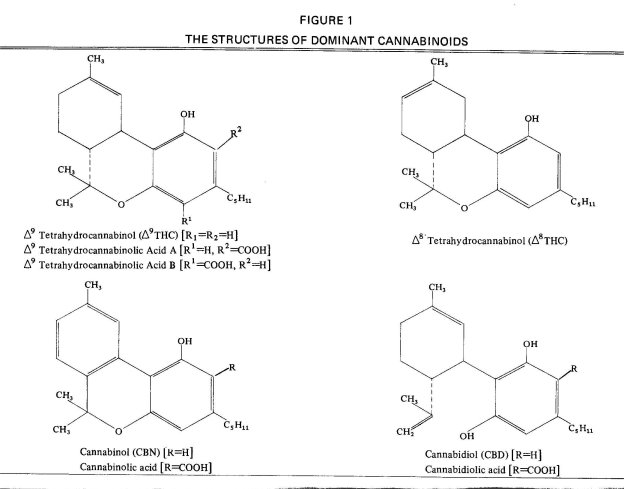
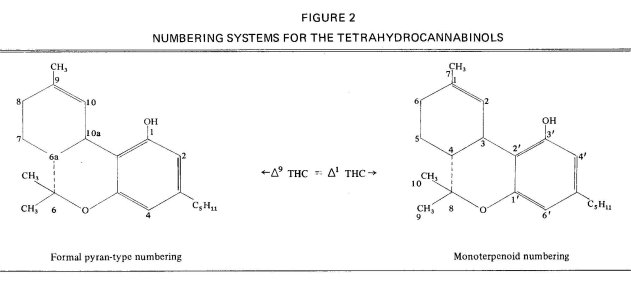
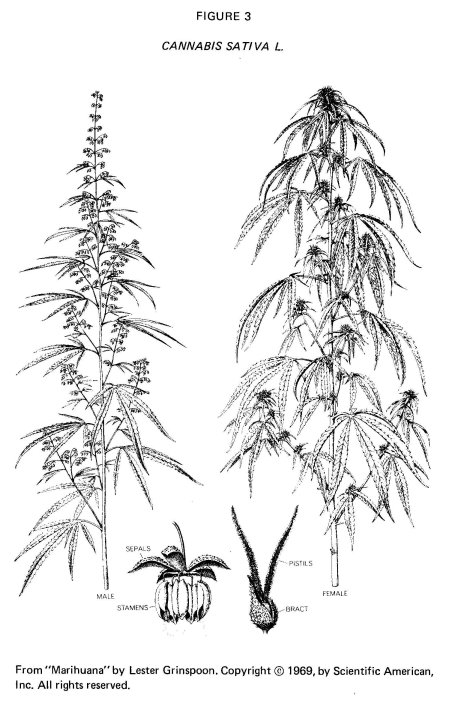
Numerous cannabinoids have been considered potential candidates in the search for the active principles of cannabis, but it appears that certain forms of THC are the primary psychoactive constituents. Commission research 440, 448 supports earlier evidence that a single isomer of THC (that is, Delta 9 THC) is generally responsible for the major psychological, behavioural physiological effects or marijuana in man.298,424 Although it would appear that cannabidiol (CBD) have little direct behavioural effect, evidence is not entirely consistent 128,298,372,424,662 and thorough quantitative studies of these cannabinoids, or Delta 8 THC, have not been conducted in humans. Propyl and methyl homologues of THC and other cannabinoids have been identified in some cannabis samples. 222,429,642 Very limited concentrations of non-cannabinoid compounds with some biological activity have recently been reported, 49,224,341 but their general contribution to the overall cannabis effects have yet to be demonstrated and would seem to be negligible.[f] The pharmacological role of Delta 9 THC will be discussed in more detail in a later section. In addition to the natural cannabis materials, during the past three decades considerable research has been done with synthetic cannabinoids (for example, DMHP, and Synhexyl or Pyrahexyl).
Since many basic questions of cannabis chemistry have only recently been resolved, serious difficulties exist in interpreting quantitative studies of cannabis carried out prior to 1971. Earlier techniques for extraction, identification, and quantitative analysis of cannabinoids in marijuana and hashish are of questionable validity and, in many instances, are grossly inadequate. Even in 1971, considerable analytic variability existed among different chemistry laboratories. The Commission has found discrepancies of several hundred per cent in quantitative Delta 9 THC analyses (and even greater differences in estimates of other cannabinoids) obtained with standard cannabis samples submitted to reputable, authorized laboratories in Canada and the United States. Similar inconsistencies, both within and between laboratories, have been noted by others. 79,91 Our informal survey of major analytic facilities in North America revealed a consensus of opinion that most of the quantitative cannabis chemistry work to date is probably not adequate, and resulting estimates of cannabinoid quantities may contain errors of considerable proportions. This would indicate that many recent Pharmacological studies of cannabis, which have attempted to specify THC dosage, may not be relied upon for specific quantitative information.
The Food and Drug Directorate [now the Health Protection Branch] of the Department of National Health and Welfare (DNHW) and, separately, the United states National Institute of Mental Health (NIMH) have initiated Programs designed to develop and communicate standard analytic techniques. The success of the programs has not been formally ascertained and no new studies of interlaboratory reliability have yet been reported. Such follow-up research, on an international scale, should clearly be given high priority.
While much is known regarding the agricultural aspects of hemp fibre production, until recently, little systematic botanical work using moden scientific techniques had been conducted into the pharmacological aspects of the plant.567' Two major botanical projects are now underway in North America and are contributing greatly towards bridging the information gap. A joint Department of Agriculture-Department of Health and Welfare project is in progress in Ottawa,568 and in the United States the NIMH is sponsoring a botanical program at the University of Mississippi.622
Depending on hereditary constitution and on the environment in which they are grown, tremendous differences in cannabis plants have been observed in such characteristics as height (less than one to more than thirty feet) and maturation time (less than two to more than ten months). Various plants differ considerably in other physical and chemical characteristics, as well. 119,161 Cannabis usually has separate male and female plants, although hermaphroditic (monoecious) forms producing flowers of both sexes occur. The two sexes are generally indistinguishable until flowering begins. The males flower first, producing long feathery stalks, and die soon after their pollen is released into the air. The plants are wind pollinated, although bees are attracted to the male flowers. The fertilized female flowers produce ovoid fruits or seeds (2-3 mm in length) surrounded by bracts of small tightly packed leaves. No seed is produced if the flower is not fertilized. Female plants growing outdoors generally continue to live until killed by inclement weather (frost in northern latitudes, drought in many southern climates) but can be kept alive indoors for years. 111,161
Cannabinoids are primarily produced on the skin of the plant by smafl glands which are most plentiful on the flowers, the bracts which cover the fruit in the female, and the smaller leaves. Larger leaves and the skin of the stalk may contain lesser, though still substantial, quantities. In addition, cannabinoids are produced internally in minute amounts in other parts of the plant, and even stems, and seeds may contain small quantities of active materials. 111,161 When grown under suitable conditions, almost all parts of both male and female forms of certain strains contain cannabinoids. The flowering tops are generally most highly valued for their pharmacologid properties and are often harvested and treated separately in the preparation of the more potent forms of cannabis.
In fresh green plants, the cannabinoids are primarily present in carboxylic acid forms, which are changed into the corresponding neutral compounds by aging or heat (for example, burning or cooking).159, 174 THC acid (THCA) for example, is apparently psychotropically inactive, and must be decarboxylated to THC prior to administration in order to produce significant effects. It has been suggested that some decarboxylation occurs in living plants growing in the tropics.420 Hashish, perhaps because of its age or conditions of treatment generally contains a smaller proportion of cannabinoids in acid form. It would appear that CBD may be a precursor compound to the psychoactive THC. CBN is not normally found in living plant material and its presence in marijuana and hashish generally represents post-harvest cannabinoid transformation. CBN content of cannabis materials might be used as a rough index of age, although other harvest and storage conditions are also likely to affect CBN concentration, and other degradation products of THC may also occur.
Environmental and genetic variables have only recently begun to be systematically explored with modern techniques. It appears that soil, temperature, water and light factors, as well as the length of the growing season, may affect the potency of cannabis. 567,568,622 However, current evidence suggests that in many situations hereditary factors dominate and that potent, high-THC plants can be grown under most temperate conditions if the seed stock is suitable. 111,561 It is often said that psychotropic cannabis cannot be grown in Canada, but this has been shown to be untrue. Quantitative analyses done for the Commission 478 of Canadian grown marijuana revealed that while 'wild' hemp may contain only traces of THC, many of the illicitly cultivated plants tested were of reasonable potency. (See Table 2 below.) Samples from four police seizures, totalling over 20 plants, averaged 0.74% THC after more than 18 months of shelf storage. Other 'home grown' samples obtained and verified by the Commission ranged from 0.02% to 3.5% THC, with a median of 0.56%. The highest value was obtained from a plant grown indoors. High potency marijuana illicitly grown indoors with conventional tungsten lighting has also been reported in the United States.159 The THC content in several hundred strains of cannabis grown at the Experimental Farm in Ottawa in 1971 ranged from near zero to close to 3%, and an average of 1,800 pounds of "manicured" marijuana (stems and larger seeds removed) were produced per acre. 568[g] Using a 3% THC strain, an acre would be sufficient to produce the THC equivalent of well over six million average 'joints'.
Several investigators have noted the existence of two chemicalphenotypesstrains in which the cannabinoids are composed primarily of CBD (referred to as the 'fibre' type since many fibre strains were found to have this characteristic), and strains in which the cannabinoids are composed primarily Of THC (referred to as the 'drug' type because of the resulting psychoactive potential). The recent study carried out in Ottawa by Small and associates examined natural variation of cannabinoids in over 300 strains and verified the existence of these polar types. 561 However, a complete spectrum of intermediate types was also found. Generally, "wild" plants, and material originating from countries north of latitude 30' N contained cannabinoids composed primarily of CBD. In contrast, material originating south of latitude 30' N possessed appreciably higher amounts of THC. However, seeds from strains grown for fibre south of latitude 30' N frequently produced Plants in Ottawa which contained intermediate concentrations of THC.
The relative potency of male and female plants has been debated for a very long time. Until recently, there was widespread belief that male plants were psychotropically inactive. This belief may have resulted from the frequently noted procedure in India and other Eastern countries of removing male plants from the field before pollination occurs.70, 295,451 This practice was apparently intended to increase the potency of the female plant, although it has not yet been scientifically documented that unfertilized female plants will become more potent. Although male plants generally weigh less than female plants, several recent studies found that males and females produced equally potent marijuana, and a new consensus began to develop, holding that the sexes were equally potent. 143,159,174,480 However, the recent study in Ottawa 568 uncovered three distinctive common patterns. In high-CBD strains, at maturity, females almost invariably contained a much greater amount of cannabinoids and although very little THC was present, it always occurred in higher trace amounts in females than in the males. More pertinently, in approximately 2/3 of the 40 or so high-THC strains examined, males and females were indeed equally potent. However, in about 1/3 of these high-THC strains, the males were notably inferior, indicating that hereditary background strongly influences the relative potency of males and females. In addition to this genetic factor, a further consideration, harvest date, appears to be very important in determining the relative potency of male and female plants. Turner recently noted that in Mississippi, in both males and females, THC content rises to a maximum in the early flowering stage, and then tends to decrease. Because males flower relatively early, their THC content reaches a peak sooner, but with further maturation potency will appear relatively greater in the females.122
In both the illicit and authorized Canadian plants discussed above, CBN and Delta 8 THC were present in only minute amounts, while a considerable range of Delta 9 THC and CBD values occurred. Similar results have been obtained from marijuana grown in Mississippi159' and England.174 The fact that relatively high CBD values are found in many wild or cultivated 'nondrug' strains (see also Table 2 below) is of considerable potential social importance, since simple techniques have been developed in the laboratory for the conversion of such 'inactive hemp' to high potency psychotropic material.122
Considerable controversy exists regarding the stability, degradation, and shelf life of cannabis preparations. It is clear that isolated or synthetic pure Delta 9 THC oxidizes to inactive forms (including CBN) relatively rapidly when exposed to air, and that the rate of this transformation increases with the temperature.111,416 CBD, CBN and Delta 8 THC seem to be more stable. THC in intact plant material may be naturally protected and considerably more resistant to change than when in isolated or hashish forms. Some investigators have recorded little shift in THC content in dry marijuana stored under simple shelf conditions for periods of months or years, while others report a significant deterioration in potency over similar intervals. 98,180,363,485,615,621 Some researchers store cannabinoids in the dark, frozen under nitrogen or in a partial vacuum to minimize degradation of change in the sample. 611 Under certain conditions, there might even be an increase in cannabis potency with the passage of time. 644 Delta-8 THC is considerably more stable, and easier to prepare in pure form than Delta 9 and, consequently, it has been frequently employed in animal research in the past two years, in spite of its limited occurrence in the plant.
Most of the data in the area of cannabinoid stability are complicated by the analytic chemistry problems discussed previously, and properly controlled studies of storage variables have only recently been initiated. Many questions regarding the effects of light, temperature, humidity, oxygen, plant enzymes, etc., on the stability of cannabinoids in storage remain to be clarified, but a sufficient number of investigators have observed little loss in potency over periods of over a year to suggest that adequate storage of dry marijuana need not be a difficult matter.178,304,556 Adequate standard storage procedures should be developed in the near future.
Illicit 'Street' Cannabis
It is often said that one of the major difficulties in scientific investigation arising from the present illicit use of cannabis is the lack of potency and quality control of materials available on the 'black market'. It is clear that in order for controlled laboratory research on a drug to have practical relevance to the social situation of ultimate interest, it is necessary to acquire an adequate picture of the present (and likely future) patterns of use, and accurate information regarding the identity, purity and potency of the drugs being consumed from illicit sources. Furthermore, detailed knowledge of the chemical characteristics of the drugs actually being used is necessary for public health purposes.
In both Canada and the United States, one frequently hears stories of alleged cannabis samples which were actually inert non-cannabinoid substances, or worse, were contaminated or adulterated with other more dangerous drugs or toxic chemicals. There have been rumours from the United States of toxic fungus on marijuana and of residual toxic compounds from indiscriminate use of pesticides by illicit cannabis farmers. United States federal agencies have been involved in and have encouraged the use of several highly toxic "defoliant" herbicide sprays for destroying or retarding illicit and wild marijuana growth in the United States.11,109,301 Some of these chemicals have been linked with birth deformities in both humans (Vietnamese) and animals, and their employment has been the cause of considerable alarm. 632 The use of one of these herbicides (2,4,5-T) has been discontinued for uses around the home and on lakes, ponds and ditch banks as well as in defense operations, including Vietnam. These restrictions, however, have not applied to the use of this chemical for weed control (such as marijuana) on non-agricultural land. It has not been determined whether any marijuana treated with these sprays has entered the 'black market'. None has been detected in Canada, but few appropriate tests have been conducted.
To date, chemical analyses of illicit cannabis samples suggest that 'bad dope' is the exception, rather than the rule. Although inert plant materials (for example, alfalfa, oregano, parsely, grass, etc.) are sometimes sold as marijuana, or used to 'cut' or dilute it for more profitable sale, and the odd beef boullion cube or brown sugar sample is represented as hashish, it would appear that in Canada, cannabis is rarely adulterated with other drugs. Pure THC has never been found on the 'street' in Canada and, with one possible exception, 497 has never been documented on the 'black market' anywhere else in the world.
The Commission has initiated several chemical studies of illicit cannabis.
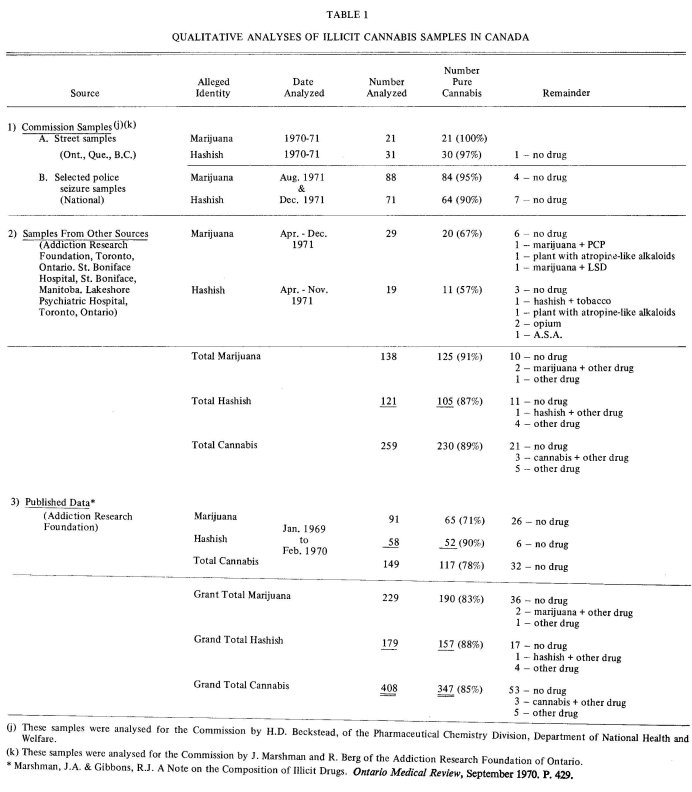
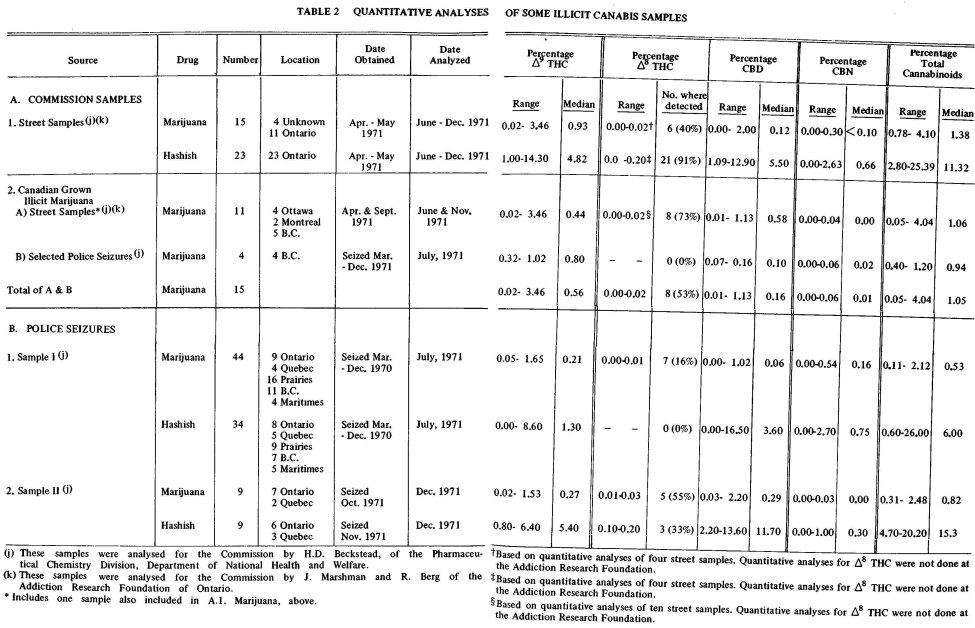
The qualitative data are summarized in Table 1. The police seizures analysed were selected from cannabis samples in storage in the vaults of the Bureau of Dangerous Drugs.[i] In addition, fifty-two cannabis samples were analysed which had been submitted to the Commission by private individuals.[j],[k] Furthermore. we surveyed all the major analytic facilties in the country for cannabis information. Of 259 samples of alleged cannabis, one sample of marijuana was mixed with PCP (phencyclidine), one was marijuana and LSD, one was hashish and tobacco, two cases were non-cannabis plant material containing atropine-like alkaloids (perhaps Jimson Weed [datura]), one was aspirin (A.S.A.), and, in two instances, opium was presented to the analyst as hashish. Twenty-one cases were reported where no drug was found on analysis. Eighty-eight per cent of the samples were cannabis, as alleged. These figures are generally similar to those published previously by Marshman and Gibbons at the Addiction Research Foundation.403 H.D., Beckstead, Dominion Analyst at the Health Protection Branch of DNHW in Ottawa, has reported seeing no cases of cannabis adulterated with other drugs in over 1,700 samples (mostly police seizures) over the past two years, although inactive (non-drug) samples were occasionally observed.43 It should be noted, however, that forensic analyses are primarily concerned with identifying suspected prohibited substances and do not generally make a special point of searching for contaminants. No cases of 'opiated' hashish or marijuana, alleged to be pure, have ever been chemically documented in Canada in spite of the popular impression that this is an established combination. Four separate samples presented to the Commission as evidence of 'opiated hash' were found to be pure cannabis resin. There have been no systematic analyses for insecticides, herbicides or infectious micro-organisms in illicit cannabis in Canada, however, and these remain a potential threat.
Police drug seizures, although in some respects a biased sample (because of the selective nature of law enforcement) are probably more representative of typical 'street drugs' than are the substances brought in to special health facilities for analysis. Unless a specific attempt is made to obtain a random sample of drugs from the 'street', the unsolicited materials brought for analysis (for example, to ARF laboratories. or to the Commission) by outside individuals are often submitted because of suspected oddities, and., consequently, as a group, probably contain a disproportionate number of deviant samples. Police seizures, by contrast, are not selected on any pharmacological basis, but data obtained from them provides a basis for direct generalization only to those sectors of the population which are the primary subjects of police attention. Although contaminated cannabis samples are retained by the authorities, non-drug substances are not generally kept unless they are part of a large seizure containing prohibited substances. These factors introduce further limitations on the interpretation of the police seizure data presented here.
In summary, it would appear that in Canada, illicit marijuana is usually cannabis, although it may be 'cut% and hashish, with some exceptions, is generally as represented. But an important question remains as to the potency of these materials.
Many of the cannabis samples described above were also quantitatively analysed for cannabinoid content. The police seizure data were made up of those samples in which less than a year had elapsed since confiscation.[i] Unfortunately, due to unforseen circumstances, the initial samples were not analysed immediately and many were stored for up to 18 months after seizure, under routine shelf conditions. This time delay may well have resulted in lower THC content due to natural degradation, but we have no accurate method of assessing this. A second, smaller sample of more recent seizures was also analysed. The Commission collected 48 illicit cannabis samples, some imported and some 'home grown', which were analysed soon after they were acquired.[j],[k] The majority of these came from Ontario. A summary of the data is presented in Table 2.
A number of significant conclusions can be drawn from this summary. The data obviously confirm earlier impressions of a wide variability in potency in both marijuana and hashish. It is clear that it is not possible to discriminate consistently between hashish and marijuana on a potency basis, since considerable overlap occurs between the respective THC distributions. THC in hashish ranged from a mere trace to an unusually high value of 14.3% and, in marijuana, from 0.02% to 3.46%. The potential for overlap is made even more explicit by reports of greater than 10% THC in selected marijuana flowering tops and bracts grown in Mississippi, England and Jamaica. 74,159,174,534 Although the data are limited in their generality, on the basis of the available information one might estimate that, in Canada, 'typical hashish' contains about 5% THC, while 'typical marijuana' contains about 0.5 - 0.75% THC. Thus it would appear that, on the average, hashish tends to be about five to ten times as potent in THC as marijuana in this country. The relative difference in potency between the two forms seems to diminish with age probably due to a greater THC degradation with storage time in hashish.
The basis for the significant difference between the 1970 police seizures and the various 1971 samples is uncertain. The Commission's 1971 'street' sample figures are more in line with frequent informal and limited scientific estimates that 'good average street grass' in North America contains about I% THC, but optimal data are not available. 280,305,363,397,414,503,678 These discrepancies may be a function of the difference in age and storage time before analysis (especially with the hashish), or result from differential selection biases in the various samples, or, less likely, may reflect a change in available marijuana and hashish to more potent materials over the past year. Some of the differences might also reflect the reliability or comparability of the chemical analytic techniques employed in the different samples. It is interesting to note that Delta 8 THC was present in less than half of these samples, and, when it did appear, only occurred in minute amounts. Carboxylic acid components were not separated from the neutral forms in these analyses.
Hashish in Canada is not merely a concentrated form of the marijuana available. It also differs significantly from marijuana in cannabinoid proportion patterns, in that hashish contains a much higher percentage of the total cannabinoids in the form of CBD and CBN. The pharmacological significance of this difference has not been adequately explored, but may not be of major importances Whether the difference in cannabinoid ratios is due to differences in age, method of curing or preparation, or environmental or genetic factors is uncertain. THC in hashish is probably less stable than in the natural plant material, and this could be partly responsible for the observed patterns. Moreover, it would appear that the marijuana is primarily from the Western Hemisphere while most of the hashish comes from the Middle East, so different cannabis strains are undoubtedly involved. Marijuana and hashish could probably be routinely and reliably discriminated chemically on the basis of the ratio of water- and lipid-soluble to insoluble fractions (mostly cellulose), although this would clearly not necessarily predict potency.
An up-to-date, continuous analysis of a randomly selected sub-sample of police seizures might be the best method of resolving the questions of cannabis purity and potency.
| < Prev | Next > |
|---|












